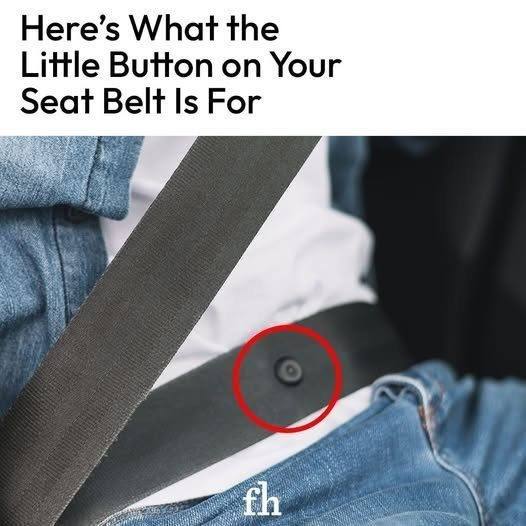Seat belts are one of the most crucial safety features in modern vehicles, saving countless lives every year. While most people buckle up without giving it a second thought, have you ever noticed the small, round button attached to your seat belt strap? It’s a tiny detail, but it serves an important purpose that many drivers and passengers overlook.

That little button is called a seat belt stop button, and its job is more significant than it appears. At first glance, it might seem like an insignificant plastic piece, but it plays a key role in ensuring your seat belt functions correctly and remains user-friendly.
When you unbuckle your seat belt, the metal latch plate (the part you insert into the buckle) tends to slide down the belt strap. Without the stop button in place, the latch plate could slide all the way down to the bottom of the belt. This may not seem like a big issue until you realize how inconvenient it would be to fish for the latch plate every time you need to buckle up. The stop button keeps the latch plate positioned within easy reach, saving you from awkwardly fumbling around for it.
Beyond convenience, the stop button also ensures proper seat belt positioning. Seat belts are designed to sit across the strongest parts of your body – your chest, shoulders, and hips. If the latch plate slips too far down the strap, it might compromise the way the seat belt sits on your body, potentially reducing its effectiveness during a collision. The stop button helps maintain consistent placement and prevents the latch plate from sliding too far, ensuring that your seat belt does its job when it matters most.
Interestingly, stop buttons are often overlooked when it comes to maintenance and repairs. Over time, they can wear out, crack, or even fall off. If this happens, you might notice that your latch plate starts slipping further down the belt. Fortunately, replacement stop buttons are easy to find and inexpensive. They can be purchased online or at auto parts stores and are generally simple to install. Many replacement kits come with two plastic halves that snap together on either side of the belt, requiring no special tools.
It’s also worth noting that seat belt stop buttons are not a universal feature across all vehicles. While most modern cars have them, older models might lack this small but helpful component. If you drive an older vehicle and notice that your latch plate keeps sliding down, installing a stop button can be a worthwhile upgrade.
Aside from their functional purpose, seat belt stop buttons also contribute to overall seat belt longevity. When the latch plate repeatedly slides down the belt, it can cause unnecessary wear and tear on the fabric. Over time, this could weaken the belt, potentially compromising its safety performance in an accident. By keeping the latch plate in place, the stop button reduces strain on the belt material and helps maintain its structural integrity.
Some people might confuse the stop button with the adjustable strap clip located higher up on the seat belt. While both are small, plastic components, their purposes are different. The strap clip is used to adjust the height of the shoulder belt to make it more comfortable for the passenger, while the stop button specifically prevents the latch plate from sliding out of place.
Understanding small details like the seat belt stop button highlights the thoughtful engineering behind everyday safety features in cars. Engineers carefully consider how each component contributes to overall safety and usability, and the stop button is a perfect example of this attention to detail.
Next time you get into your car and buckle up, take a moment to appreciate that little button. It might seem like an unimportant piece of plastic, but it’s doing more for your comfort and safety than you realize. If yours is missing or damaged, don’t hesitate to replace it. A well-functioning seat belt isn’t just about buckling up—it’s about making sure every detail works as intended to protect you and your passengers.
So, the next time someone asks, “What’s this little button on the seat belt for?” you’ll have a confident answer. It’s not just a random piece of plastic—it’s an essential part of your seat belt system, designed to make your driving experience safer and more convenient.





